Understanding Cow Lift Slings in Modern Agriculture
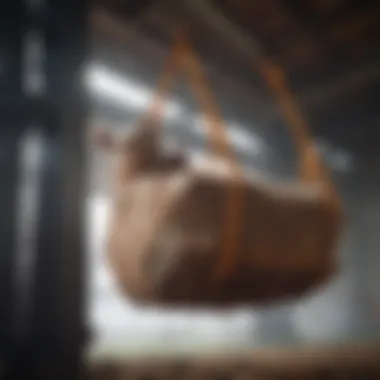
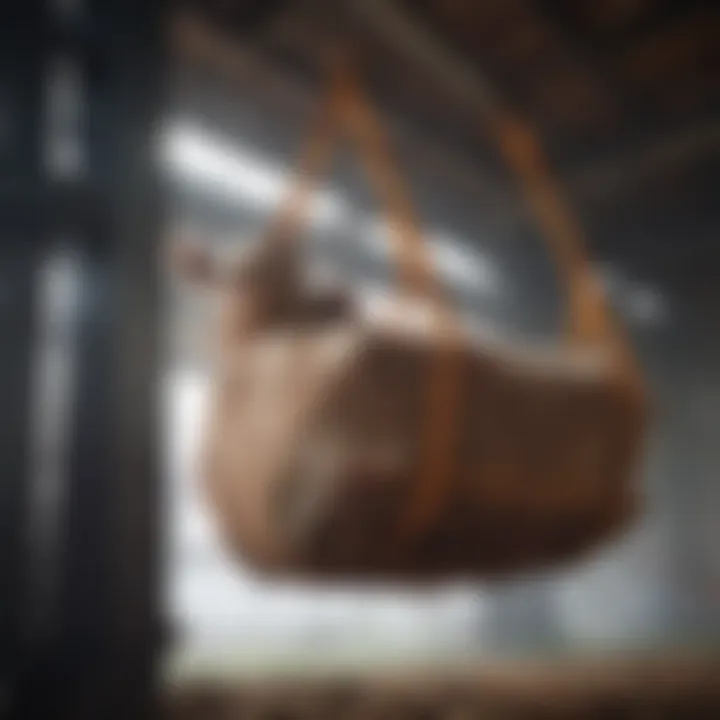
Intro
Cow lift slings are essential tools in the realm of modern agriculture. They offer a specialized solution for lifting and transporting livestock, especially cows that may be injured or unable to stand on their own. This section introduces the key concepts and terminology surrounding cow lift slings, shedding light on their design, functionality, and significance within the agricultural industry.
Key Concepts and Terminology
Basic Definitions
Cow lift slings, also referred to as cattle slings, are made of durable fabric and designed to support and lift cows safely. The sling typically wraps around the animal's body and is attached to a hoist or lifting device. The primary function is to assist in the recovery of cows that have become incapacitated, whether due to health issues, calving difficulties, or other reasons.
Historical Context
The use of lifting equipment in agriculture is not new. Traditionally, farmers relied on manual labor or less efficient tools to manage heavy livestock. As the livestock industry evolved, so did the need for safer and more effective lifting solutions. The development of cow lift slings represents a significant advancement in animal care. These innovations reflect a growing awareness of animal welfare and the importance of quickly attending to distressed livestock.
Recent Innovations and Trends
Technological Advancements
In recent years, several technological improvements have enhanced the design and functionality of cow lift slings. For example, modern materials such as high-strength synthetic fabrics make these slings both lighter and stronger. Some models now integrate adjustable components, allowing for a better fit and increased safety during lifting.
Sustainable Practices
Sustainability is becoming a focus within agriculture. Cow lift slings are now often constructed from recyclable materials. This reflects a broader commitment to reduce environmental impact. Farmers are increasingly looking for tools that not only improve efficiency but also align with sustainable agricultural practices.
Practical Applications and Techniques
Step-by-step Guides
Using cow lift slings effectively requires understanding proper techniques. Here are some general steps a farmer should follow when using a sling:
- Assess the Situation: Ensure the cow needs assistance and evaluate its condition.
- Select the Right Sling: Choose a sling that fits the size and weight of the cow.
- Prepare the Area: Clear the area around the cow for safety.
- Position the Sling: Gently roll the cow onto its side, then slide the sling under it.
- Secure the Sling: Ensure it is snug but not overly tight to avoid injury.
- Lift Carefully: Use a hoist to lift the cow slowly and steadily, monitoring the animal's reaction.
- Lower Safely: Once the cow is in a safe position or in a trailer, gently lower it back down.
Case Studies
Recent case studies highlight the benefits of cow lift slings. For instance, a farm in Wisconsin reported a 40% decrease in recovery time for cows post-calfing when using slings as compared to older methods. Such examples illustrate the positive impact these tools can have on both animal welfare and farm efficiency.
"Using a cow lift sling not only helps the animal but also supports the farmer's efficiency in livestock management."
Preamble to Cow Lift Slings
In contemporary agriculture, the use of technology and specialized equipment plays a significant role in enhancing the efficiency of livestock management. One such piece of equipment is the cow lift sling, designed specifically to assist in lifting and transporting cows safely. Understanding cow lift slings is crucial for farmers and animal care professionals who seek to minimize stress and prevent injury to livestock during handling processes. This section will elucidate key aspects of cow lift slings, highlighting their importance and benefits in practical applications, as well as considerations surrounding their use.
Definition and Overview
A cow lift sling is a supportive device used to safely lift and move cows, particularly when they are unable to stand on their own due to injury, illness, or exhaustion. These slings are crafted from strong, durable materials to withstand significant weight, ensuring the safety of both the animal and the handler. The basic design consists of a large fabric body, often padded for comfort, which is secured around the cow's body. Adjustable straps allow for a secure fit, while a system for attaching to lifting devices simplifies the process of raising and moving the cow.
These slings offer many benefits, including:
- Providing essential support during veterinary procedures
- Facilitating safe transportation of injured animals
- Reducing the risk of further injury to both livestock and handlers
Historical Context
The concept of lifting and supporting livestock has deep roots in agricultural history. Initially, farmers relied on manual methods to lift cows, often using brute strength or rudimentary tools. These techniques put both the animals and handlers at risk and were not always effective. As the agricultural industry evolved, so too did the methods of managing livestock.
The advent of modern materials, such as nylon and polyester, in the late 20th century marked a turning point. Straps made from these synthetic fibers provided the necessary strength and flexibility, allowing for the design of advanced cow lift slings. Technological innovations and a deeper understanding of animal welfare have spurred the development of various models to cater to the specific needs of the livestock industry.
Thus, cow lift slings represent an intersection of tradition and modernity. They embody a response to the growing demands for mechanical solutions in agriculture and the increased emphasis on the humane treatment of animals.
Types of Cow Lift Slings
Understanding the types of cow lift slings is crucial for optimizing their use in livestock management. Each type offers unique benefits suited for various applications. From material composition to design variations, selecting the appropriate cow lift sling ensures efficiency and safety in animal handling.
Material Composition
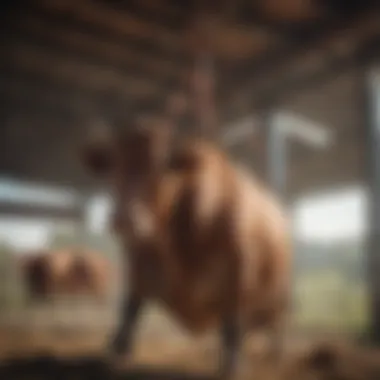
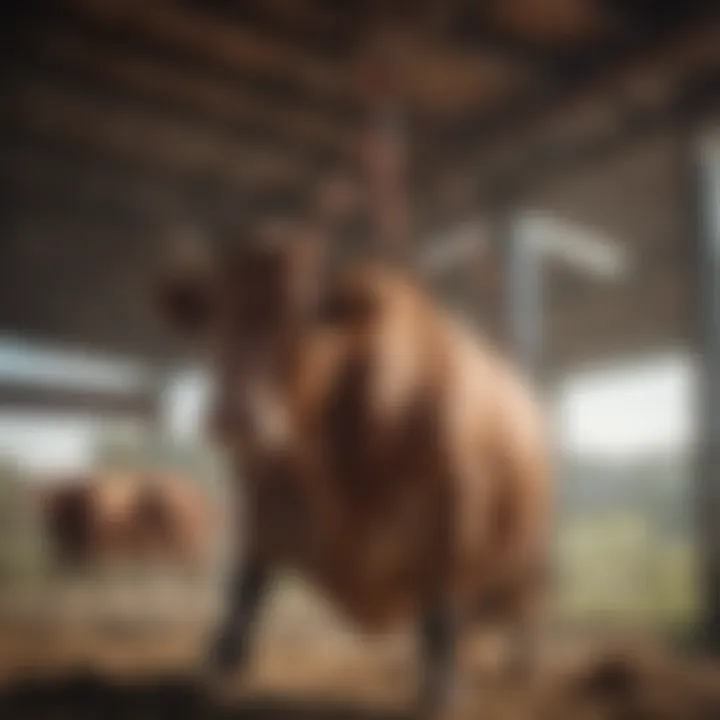
Nylon slings
Nylon slings are known for their strength and flexibility. This material has high tensile strength, allowing it to carry significant weight without stretching excessively. Nylon is also weather-resistant, which makes it suitable for outdoor farm conditions. Its lightweight nature simplifies storage and handling, making it a practical choice. However, it may not endure high temperatures well, which can be a disadvantage in some environments.
Polyester slings
Polyester slings provide excellent durability and resistance to abrasion. The material does not absorb moisture, reducing concerns about mold or mildew, which can be vital in livestock care. Polyester's strength is similar to nylon, but it is less stretchy, providing a stable grip during operation. However, it can be more expensive than nylon, which might be a consideration for some budget-conscious farmers.
Steel components
Steel components in cow lift slings offer unparalleled strength and stability. They are essential for heavy-duty applications, particularly in rescue operations or when lifting larger breeds. Steel’s rigidity ensures minimal deformation during use, providing peace of mind to operators. However, the weight of steel components can complicate usage, making them less favorable for routine tasks. Additionally, rust can be a concern without proper maintenance, which requires farmers to be vigilant.
Design Variations
Standard designs
Standard designs of cow lift slings typically focus on basic functionality. These slings are built to lift animals safely and efficiently, catering to common needs in livestock management. Their straightforward construction allows for ease of use and vetting when selecting the right sling. However, their generic nature might not serve unique scenarios effectively, where customization could be necessary.
Customized solutions
Customized solutions are tailored to specific requirements of farmers or veterinarians. These designs can address particular animal sizes or unique lifting situations. Customization adds value by ensuring that the sling perfectly fits its intended task. However, the cost of such slings often exceeds standard designs and may not be feasible for all users.
Emergency models
Emergency models of cow lift slings are designed for quick deployment during critical situations. These slings prioritize speed and efficiency, often featuring easy-to-use fastening mechanisms. Their designs may include features that protect the animal while ensuring rapid lift. The downside could be a compromise in durability when compared to standard or custom-made options, making them less suitable for long-term use.
Functional Mechanisms
Understanding the functional mechanisms of cow lift slings is essential to appreciating their role in livestock management. These mechanisms detail how these tools operate effectively to ensure the safe lifting and moving of cattle when necessary. The importance of these mechanisms lies not only in their technicality but also in their direct impact on animal welfare and operational efficiency. Knowledge of how these slings function can aid farmers in selecting the right equipment that meets their livestock handling requirements.
Weight Distribution Principles
Weight distribution is a crucial concept in the design and functionality of cow lift slings. Proper distribution allows for the safe lifting of cows, minimizing stress on both the animal and the equipment. There are several fundamental principles to consider:
- Center of Gravity: Understanding the center of gravity of the cow is vital. This point affects how the weight is held and allows for balanced lifting.
- Surface Area: Increasing the surface area of the sling helps distribute the weight more evenly across the cow’s body, reducing the risk of injury.
- Adjustment Capabilities: Many slings have adjustable straps or components that let the user modify the fit. This adaptability is essential for managing different weights and sizes of cows.
Ensuring proper weight distribution can significantly reduce strain during lifting operations. This principle not only enhances the safety of the lifting process but also prolongs the lifespan of the equipment. A good weight distribution design makes it easier for operators to manage loads without excessive physical exertion.
Load Bearing Capacities
Load bearing capacity denotes the maximum weight a cow lift sling can support safely. This specification is vital when considering the appropriate selection of slings for various types of cattle. The capacity of these tools depends on several factors:
- Material Strength: The materials used, such as nylon or polyester, have defined strengths that primarily determine the maximum load each sling can handle. For instance, heavy-duty polyester slings often have higher load capacities compared to lighter variants.
- Design Specifications: Certain designs are optimized for higher loads. Slings made with reinforced stitching or additional support components tend to carry heavier loads without compromising structural integrity.
- Safety Factors: When selecting a cow lift sling, it is vital to consider the safety factors outlined by the manufacturer. Typically, a load capacity rating will include a safety margin to account for dynamic forces that may occur during use.
A thorough understanding of load bearing capacities leads to more informed decisions in the selection and use of cow lift slings. Choosing equipment with appropriate load limits ensures the safety of both the livestock and the farmer, avoiding potential accidents and injuries.
Applications in Livestock Management
The applications of cow lift slings play a pivotal role in modern livestock management. These devices are indispensable for various scenarios on a farm. Their usage enhances both the efficiency and safety of handling large animals. Properly utilizing cow lift slings can reduce the risk of injury to both livestock and farm workers. They are not just a tool; they represent a method to ensure the well-being of animals while streamlining farm operations.
Rescue Operations
In situations where a cow is down or injured, cow lift slings become essential. The ability to safely lift and transport an animal is crucial. Without suitable equipment, injuries can worsen. Cow lift slings designed for rescue operations can distribute weight evenly, decreasing the strain on an injured animal. These slings often feature quick-release mechanisms to facilitate swift actions in emergencies.
- Facilitates quick recovery for injured cows
- Minimizes stress on the animal during transport
- Provides stability and support while moving
The rehabilitation of livestock is vital to farm functionality. Effective rescue is not simply about immediate aid. It also aligns with long-term health management for animals. By addressing emergencies promptly, farmers can maintain the overall productivity of their herds. This contributes significantly to the economic sustainability of the farm.
Veterinary Care
Veterinarians increasingly rely on cow lift slings during medical examinations and procedures. For instance, when performing surgeries or diagnostics, it is crucial to position animals in a way that eases their stress and pain. Properly fitted slings can assist in stabilizing the animal. They ensure that the veterinarian can access the required areas without causing unnecessary movement.
Key benefits include:
- Efficient positioning for treatment
- Enhanced comfort for the animal
- Ability to keep the animal still during procedures
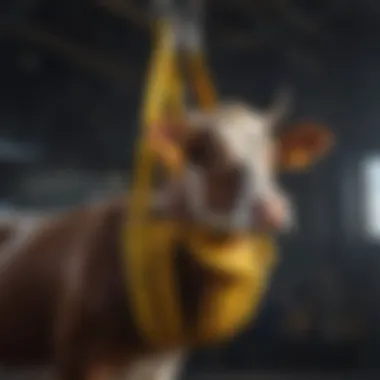

These advancements reflect the integration of cow lift slings into veterinary practices. This not only improves outcomes but also enhances the overall experience for both vet and animal. Thus, this application supports a collaborative environment in animal health, which is increasingly recognized for its impact on livestock welfare.
Transportation
Transporting cattle often poses challenges. Cow lift slings serve as a solution to make this process safer and more humane. Whether moving to a new pasture or to market, using slings can prevent injuries that might occur through improper handling. Their design allows livestock to be loaded and unloaded efficiently and humanely.
Consider these points when discussing transportation:
- Reduces stress for the animal during transit.
- Ensures compliance with welfare standards.
- Protects the integrity of the livestock during movement.
Transporting cows should prioritize animal welfare as a core principle. When slings are integrated into transport activities, it signals a commitment to best practices in livestock management. This commitment can translate into fewer injuries, higher quality animals, and ultimately, better profitability.
Efficient cow transport not only benefits the animal but also enhances the overall operational effectiveness of a farm.
In summary, cow lift slings have transformative effects on rescue operations, veterinary care, and transportation. Each application contributes uniquely to livestock management. This versatility reinforces the essential nature of cow lift slings in an evolving agricultural landscape.
Safety Considerations
In the realm of livestock management, the use of cow lift slings brings significant advantages, but these benefits come with certain responsibilities, particularly concerning safety. Understanding safety considerations is crucial in ensuring the well-being of both livestock and personnel. Improper use of lift slings can lead to injuries, not only to the animals but also to the handlers involved.
Implementing effective safety protocols and preventative measures can greatly reduce potential risks associated with cattle lifting operations while maximizing efficiency and productivity. Assessing safety involves an awareness of the devices, user familiarity, as well as environmental factors that may impact operations.
User Protocols
User protocols are foundational in ensuring safety during the operation of cow lift slings. Operators must undergo thorough training to understand the equipment's capabilities and limitations. This includes knowledge about the correct weight limits each sling supports. For instance, a nylon sling may have different specifications compared to a polyester model, and using the wrong type can compromise strength and safety.
The following points should be considered in user protocols:
- Pre-Operation Checks: Always inspect the sling for any signs of wear and tear before use. Checks should include visual inspections for frays, cuts, or other damages that could affect strength.
- Proper Attachment: Ensure that the sling is correctly attached to the lifting device, with all necessary locking mechanisms engaged. Any slack in the sling can cause instability during lifting.
- Operator Awareness: Operators must remain attentive during the lifting process. This includes monitoring the animal's behavior as well as conditions surrounding the lift.
- Team Communication: Effective communication among team members is vital. Use clear signals or predetermined commands when lifting is in progress to avoid misunderstandings.
Preventative Measures
Preventative measures are essential in enhancing safety when using cow lift slings. They not only safeguard the livestock but also promote a safe working environment. By taking proactive steps, the likelihood of incidents can be significantly minimized. Some of the key preventative measures include:
- Regular Training: Conduct regular training sessions for all personnel involved in lifting operations. Sessions should cover safety practices, updates on technologies, and emergency response protocols.
- Routine Maintenance: Schedule frequent maintenance and assessments of lifting equipment. Proper care extends the life of the equipment and ensures it operates effectively.
- Safety Gear: Encourage the use of personal protective equipment, such as gloves and steel-toed boots, to reduce the risk of injury during operations.
- Adequate Space: Make sure the lifting area is adequately cleared. A clutter-free environment reduces distractions and potential hazards while operating the lifts.
Safety in livestock management entails understanding both the technology and the responsibilities that come with its use. Knowledge and vigilance can prevent accidents that could result in injury or loss.
By emphasizing user protocols and preventative measures, the agricultural industry can move towards a safer operational framework. Properly implemented safety considerations not only protect livestock but also enhance the overall productivity of farm activities.
Economic Impact of Cow Lift Slings
The economic ramifications of cow lift slings extend far beyond their initial cost. As essential tools in livestock management, they contribute significantly to operational efficiency and productivity. Their implementation can reduce labor intensity, enhance animal welfare, and minimize the risk of injury to both animals and handlers. Understanding the economic impact of these slings is crucial for farmers looking to optimize their investment in livestock equipment.
Cost-Benefit Analysis
A comprehensive cost-benefit analysis presents a pragmatic view of cow lift slings. Initially, farmers must consider the purchase price of the slings, but this upfront investment can yield substantial long-term savings. Benefits include:
- Reduction in Labor Costs: Utilizing cow lift slings allows fewer laborers to perform heavy lifting tasks, thus decreasing wage expenditures.
- Improvement in Animal Health: Timely interventions facilitated by slings help in maintaining animal health, reducing veterinary costs in the long run.
- Increased Productivity: Faster recovery times for injured animals lead to improved productivity, enabling farmers to recoup costs more quickly.
- Enhanced Worker Safety: With safety measures in place, the likelihood of workplace accidents decreases, potentially lowering insurance premiums.
Evaluating these factors shows that, despite the initial costs, the benefits can vastly outweigh the expenses incurred when investing in cow lift slings.
Market Trends
Analyzing current market trends reveals how cow lift slings are adapting to the evolving needs of the agricultural sector. Demand for these slings has been on the rise, influenced by various factors:
- Rising Awareness: As more farmers recognize the importance of animal welfare, the demand for equipment that aids in safe handling increases.
- Technological Advancements: Innovations in materials and design are making cow lift slings more durable and user-friendly.
- Growth of Livestock Industry: With the livestock industry expanding globally, the need for efficient management solutions, including cow lift slings, grows concurrently.
Furthermore, manufacturers are responding to consumer needs by developing specialized slings. These are designed for specific purposes, such as emergency rescues or for use in veterinary practices, thus expanding market opportunities.
The growth of cow lift sling technology reflects broader trends in livestock care that prioritize efficiency and safety.
In summary, the economic impact of cow lift slings is multifaceted, encompassing both immediate and long-term financial benefits for livestock operations. A vigilant understanding of costs, benefits, and market dynamics will allow farmers and agricultural enthusiasts alike to make informed decisions, paving the way for smarter investments in livestock management.
Maintenance and Care
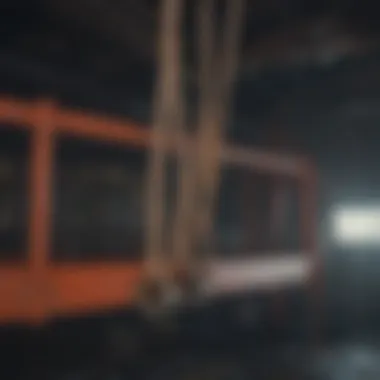
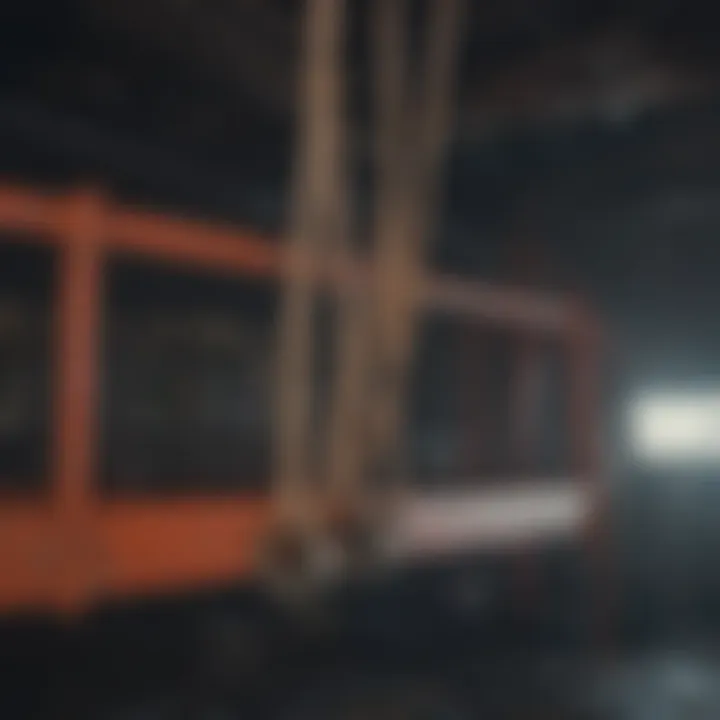
The effective operation of cow lift slings relies on proper maintenance and care. Attention to these aspects can extend the lifespan of the equipment and ensure optimal performance. There are several elements that contribute to maintenance and care, including regular inspections and cleaning procedures. By prioritizing these actions, farmers can avoid costly replacements and enhance the safety and efficiency of their operations.
Regular Inspections
Regular inspections of cow lift slings are essential for ensuring their safety and functionality. Inspections should focus on evaluating wear and tear, fraying, or other potential issues that might compromise performance. It is advisable to conduct these checks before each use and at regular intervals throughout the year. During inspections, users should follow these key points:
- Check for fraying or cuts: Inspect the fabric closely, particularly around stress points. Any signs of damage should be addressed immediately.
- Examine hardware components: Ensure that buckles, clips, and other attachments are secure and not rusted or worn.
- Look for signs of stretching or deformation: Over time, materials may stretch or lose their original shape, impacting load capability.
By maintaining this routine inspection schedule, the risks of failure during operation are minimized. Also, users can identify small issues before they escalate into larger, more expensive problems. Regular checks promote confidence and safety in livestock management tasks.
Cleaning Procedures
Cleaning cow lift slings is another critical aspect of maintenance. Proper cleaning helps prevent the buildup of dirt and debris which can lead to premature wear. Here are some basic cleaning procedures to follow:
- Use mild soap and water: It is best to use a mixture of mild soap and water for cleaning. Harsh chemicals could degrade the sling materials over time.
- Rinse thoroughly: After applying the soap solution, rinse the slings well to remove any residue that may remain.
- Air dry: Always allow cow lift slings to dry completely before storing. Storing damp slings can lead to mold and further material degradation.
Couponing these cleaning practices into regular maintenance ensures that cow lift slings remain in good condition.
"A well-maintained cow lift sling not only enhances operational efficiency but also ensures the safety of both the livestock and the users."
By caring for these tools properly, farmers can sustain their efficacy and safeguard their investment in livestock management. Adopting these maintenance and care practices is crucial for effective agricultural operations.
Future Developments in Cow Lift Sling Technology
The landscape of agricultural technology continually evolves, with future developments in cow lift sling technology playing a crucial role in enhancing livestock management practices. These innovations promise improvements in efficiency, safety, and overall effectiveness of slings used for lifting cows. As farmers and agricultural professionals seek the best options for their operations, understanding these advancements is essential. Such advancements will not only provide functional enhancements but also address growing safety concerns, economic factors, and the evolving needs of the livestock industry.
Innovative Materials
The use of innovative materials in the construction of cow lift slings can significantly impact their performance and longevity. Traditionally, slings were made from materials like nylon and polyester, which have their advantages but also limitations. New materials such as high-tenacity polyethylene fibers or composite fabrics can offer benefits like increased strength without adding excessive weight. These materials can withstand more stress and strain, which is crucial when lifting heavy animals.
Furthermore, these advanced materials often exhibit properties such as water resistance or UV resistance. This ensures that slings remain durable even when exposed to harsh environmental conditions. By investing in innovative materials, farmers can reduce replacement costs and enhance the overall safety of their lifting operations.
"The transition to advanced materials not only prolongs the life of cow lift slings but it also ensures that livestock is handled safely and effectively."
Automation in Design
Another important area of future development is the automation in the design of cow lift slings. Automation can streamline the manufacturing process, leading to higher precision in the fabrications. This precision contributes to better load distribution and enhanced reliability in lifting operations.
Additionally, automated designs can adapt to specific farm needs. Such custom fits can factor in the size and weight of different cattle breeds, ensuring that the slings perform optimally in various scenarios. Smart technology integrated into sling design can monitor weight limits and stress levels, providing real-time data that farmers can utilize to measure safety margins.
Embracing automation signifies a shift towards smarter, data-driven agriculture. With these advancements, the burdens faced by farmers during the lifting and transportation of livestock can be alleviated. The future holds promising advancements that can transform traditional practices, making livestock management more efficient and safe.
Finale
The conclusion serves as a critical component of this article, as it encapsulates the key points discussed about cow lift slings. Understanding the implications of slings in livestock management is essential for farmers and enthusiasts alike. This section consolidates the various factors that make cow lift slings not just tools, but vital assets in modern agriculture.
Summary of Findings
Throughout this article, we have examined the intricate details surrounding cow lift slings. They are not merely aids for handling livestock but are engineered systems that ensure safety and efficiency. The findings can be summarized as follows:
- Material Variety: Cow lift slings are made from diverse materials such as nylon and polyester, which affect their durability and load capacity.
- Design Adaptability: From standard designs to customized solutions, the ability to tailor slings for specific needs enhances their functionality.
- Safety Protocols: Established safety procedures are critical. They not only protect the livestock but also safeguard the users during operations.
- Economic Significance: Analyzing the cost-effectiveness of cow lift slings reveals their potential to improve operational efficiency and reduce veterinarian costs during emergencies.
"The right equipment can significantly enhance livestock management practices, paving the way for innovative animal care solutions."
Final Thoughts
In a world where livestock management is increasingly integrated with technology, staying informed about equipment like cow lift slings becomes paramount. This article has aimed to provide comprehensive insights into their design, functionality, and economic implications, urging stakeholders to consider the long-term benefits of adopting modern solutions for livestock care.
Cited Works
Cited works encompass a variety of materials such as peer-reviewed journals, agricultural manuals, and case studies on livestock equipment. These resources offer invaluable insights into the practical aspects of cow lift slings. For instance, a research paper analyzing the efficiency of different materials can help future buyers make informed decisions.
It is crucial to look into the quality of these sources. Peer-reviewed journals provide credibility, while industry reports may contain current trends and developments. Examples of significant citations might include:
- Scholarly articles on the engineering principles of load-bearing equipment.
- Manuals published by agricultural organizations on safety under livestock management.
- Studies conducted on the economic viability of using cow lift slings in large-scale farming operations.
Further Reading
Further reading extends the conversation and connects readers to a broader context. Resources such as agricultural websites, online forums like Reddit, and trusted publications on livestock management can enhance understanding. Engaging with diverse materials can reveal varying perspectives on cow lift sling usage. For instance, following discussions regarding new technologies or maintenance tips can be beneficial for farmers.
Moreover, detailed guides and reports are invaluable, offering practical advice on implementation and safety protocols. It can also be useful to follow links to resources like Wikipedia or Britannica for a more general background on livestock care or relevant technologies. Accessing these materials can deepen one's knowledge and enhance overall livestock management strategies.















